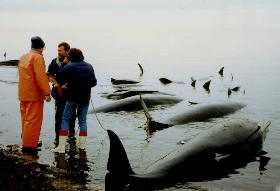"The ocean is a precious resource shared by all the world's peoples," said Jean-Michel Cousteau. "The LFA permit is nothing less than a license to kill, and we are enormously grateful to the court for protecting our children's heritage."

THE PROBLEM: US Navy has found a way to generate one of the loudest sounds that humans could possibly put in the ocean that will seriously harm cetaceans.
The Surveillance Towed Array Sensor System Low Frequency Active sonar has been developed by the US Navy to easily detect the "quieter" submarine and independents divers. The LFA is so effective that the Navy plans to launch LFA fleets throughout the world's oceans on a routine basis. The LFA's low frequencies can travel for hundreds of miles, effectively leading to thousands of covered cubic ocean miles. Despite the breakthrough in marine technology, the LFA is seen as extremely dangerous to marine mammal hearing. Distruptions in thier calving, breeding, feeding, and communication are expected.
“There may be other impacts, too, like those seen when a glass shatters as an opera singer hits a high note. A sound wave can cause material that resonates in its frequency to vibrate, shatter, shear, or tear. Some air spaces in mammals (and fish) may react to LFA sonar in this manner. All of this is too high a price to pay for questionable security against the latest breed of submarines.”-HSUS
As required, the Navy has produced an Environmental Impact Statement to review the effects that the LFA sonar will have on the marine environment. The National Marine Fisheries Service will regulate how the LFA is used in oceans.
“Our principal concern is that the environmental analyses upon which the Navy and NMFS are relying have several shortcomings:
-Their assessments are based on insufficient data about how sound affects marine mammals, sea turtles, and other marine animals.
-They over interpret the small amount of data available on sound and marine mammals, and reach non-precautionary (and poorly supported) conclusions that LFA sonar will not harm marine mammals in any significant way.
-Marine mammals, sea turtles, and other marine animals. At the same time, they place unjustified confidence in the Navy's ability to prevent such injuries and deaths through detection of marine animals within a "zone of exclusion" around the sound source.
-They do not discuss alternate hypotheses for observed marine mammal reactions to loud, low-frequency sound.
-They set an arbitrary standard for the level of sound that will harass or injure marine mammals and sea turtles. This standard has no empirical basis and is vastly less precautionary than standards being established by other countries.
-They neglect to adequately discuss the shortcomings of LFA sonar in accomplishing the Navy's goal of detecting "quiet" enemy submarines while remaining undetected itself.”-HSUS
In March of 2000, after a Navy exercise with mid-frequency active sonars in the Bahamas, a mass stranding of beaked whales, minke whales, and one dolphin was reported. Studies show that the whales and dolphin died from the intense impacts that the loud sounds had in their air spaces.
